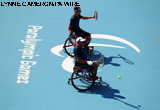 I never thought that they would ask me back to help out during the Paralympics. But the call came, and it was for Eton Manor and the wheelchair tennis events. So, I’ll be working at a completely different type of event, in a different venue. But it is still in the Olympic Park—the core of the games!
I never thought that they would ask me back to help out during the Paralympics. But the call came, and it was for Eton Manor and the wheelchair tennis events. So, I’ll be working at a completely different type of event, in a different venue. But it is still in the Olympic Park—the core of the games!
Like everyone, except those lucky enough to be at the stadium, I watched the opening ceremony on TV, and from now on, I’ll not call anyone disabled. Superhuman, more like, and with Bladerunner Pistorius in both games, what some superhumans are capable of doing will become more common in the future, with multiple ethical and definition problems to over come. One of my own colleagues is superhuman, in that they are a doctor who practices from a wheelchair, as well as playing tennis to a high standard, and they are working as crowd doctor. I was initially asked to be a crowd doctor at the Paralympics, and turned it down, keen as I was to take part, as I just don’t have the skills for the job that my superhuman colleague has.
Unlike my time at the Aquatics Centre, where our “Field of Play” recovery team was entirely separate from the crowd doctor and first responder teams, we are based in a very substantial tent outside court one, labelled the spectator medical centre. The main thoroughfare to and from all the four courts passes right outside our door, and our venue medical manager policy is to integrate both teams. So we patrol the courts, peeping in at the play and we are even able to spend some time watching. And the result is a rush of business!
Already on the first day of play for tennis, there was a collapse in the stands, and near collapse by a fellow Games Maker, more blisters than I could count, two nose bleeds, and a gynaecological emergency. We also had a run on requests for paracetamol for headaches, so it’s good that we have over 2000 tablets in our store cupboard.
But the Games, the Games! We saw the current womens’ world champion Esther Vergeer reveal her secret weapon in a first round match. Any wheelchair user needs to be stable in their seat, and an athlete even more so. The basketball players are strapped to their chairs, so much so that when they fall over, they just (just!) flip themselves back again upright, like a kayaker doing an eskimo roll. But it cannot be comfortable or good for the lower limb circulation. Vergeer has developed a double knee cup that encloses her knees and lower thighs, that must form a rigid foundation for her upper body strength to react against, no doubt increasing her manoeuvrability. Moreover, although her chair’s chassis looks bulky and heavy, I am reliably told it is made of titanium. So it is light, strong, rigid, and with the knee cup device—watch out for demands that this “aid” is illegal.
John Davies is a consultant anaesthetist in Lancaster, who takes part in motorsport as a competitor and as a rally doctor. He volunteered as part of the Olympic games medical team in the aquatic centre. Over the next couple of weeks he will be blogging from the Olympic Park about his experience during the Paralympic games.
Photo credit: LYNNE CAMERON/PA WIRE